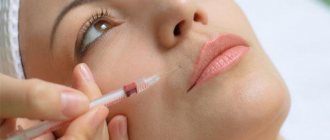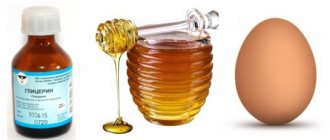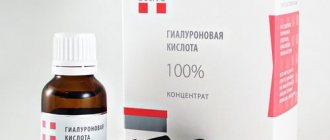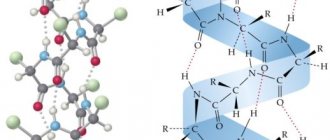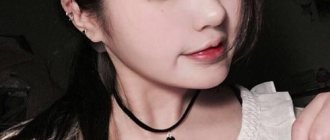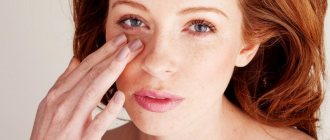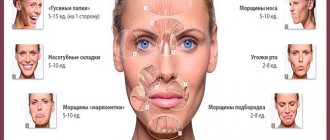To preserve youth and maintain healthy skin, modern cosmetology offers many minimally invasive procedures with maximum benefits and minimal risk of unwanted consequences. One of them is hyaluronic acid injections. This substance is capable of many things; its use allows you to carry out many procedures for different skin types for almost any problem. Contour plastic surgery, mesotherapy and biorevitalization are performed in cosmetology with the participation of hyaluronic acid.
Hyaluronic acid injections are a minimally invasive alternative to plastic surgery with a lower risk of unpleasant consequences, faster skin restoration and lower cost.
Types of procedures with hyaluronic acid
Pure hyaluronic acid is not used in cosmetology; injections are carried out using a special gel containing low molecular weight acid. The substance has an amazing skin healing effect and a quick onset of results.
There are several methods for introducing low molecular weight acid in cosmetology.
- Biorevitalization, or microinjections (best suited to the definition of “beauty injections”) is a method of delivering a beneficial substance into the deep layers of the skin to eliminate microcracks, shallow age-related wrinkles and to correct the contour of the face. The drug is injected a few millimeters with a thin needle; minor adverse reactions may occur after the procedure.
- Mesotherapy involves the delivery of useful substances using a special roller with small needles onto which the drug is applied. Helps get rid of stretch marks, small scars and scars.
- Injections are the most traumatic technique; they differ from microinjections in the depth of insertion of the syringe. It is used to influence the deep layers, where natural hydration and nutrition of the epidermal tissues occurs, and is indicated for tightening, changing the contour, and enlarging the lips.
For each procedure, one of two types of hyaluronic acid can be used - monophasic and biphasic fillers. In the first case, the drug is used primarily for contouring: lip augmentation, changing the shape of the forehead, cheekbones, and tip of the nose. Two-phase fillers (“Restylane”) are preparations with 1 g of gel; they are used for deep correction to quickly restore skin elasticity.
Fillers for fillers
Long-acting and permanent-acting drugs are used for injections. They differ in composition and administration technique. Long-acting preparations contain 2 main components - hyaluronic acid and collagen. They compensate for the lack of natural substances, which is accompanied by dry skin, loss of elasticity and the appearance of wrinkles. Natural collagen is an element of connective tissue, and hyaluronic acid is contained in the intercellular space, providing hydration.
The duration of the effect largely depends on the combination of drugs. The introduction of collagen alone gives results for 3-4 months, with hyaluronic acid - for 5-7 months.
Semi-permanent or long-acting preparations are indicated to eliminate deep wrinkles and folds. They are microsphere particles or gel. The effect of their use lasts for 12-18 months.
The principle of action of hyaluronic acid
Hyluronic acid is a natural substance, a polysaccharide, present in the human body and capable of:
- - attract water
- - moisturize the skin surface,
- - improve cell metabolism.
One molecule of acid binds 500 molecules of water. After 30 years, the body’s production of hyaluron slows down, and it is necessary to artificially replenish the lost function by injecting the drug into the surface of the skin. Hyaluron creates a protective layer that moisturizes the skin, eliminates wrinkles and the skin becomes velvety and elastic.
After the expiration date, the acid is eliminated from the body naturally without negative effects.
There are several types of hyaluronic acid:
- – low molecular weight – used as external creams to reduce inflammatory processes,
- - medium molecular weight - in demand for the treatment of eye diseases and joints,
- - high molecular weight - used in injections to give the skin firmness and elasticity,
Operating principle
The filler contains several active components, each of which has a separate positive effect on the skin. Additional substances in the composition are also necessary to accelerate the activation of hyaluronic acid and its better acceptance by the body without adverse reactions.
Getting under the skin, the substances create an invisible frame that evens out the skin texture and fills the deep layers with looped substances. A number of reactions in response to the ingestion of the drug lead to an amazing effect - the skin glows with health, wrinkles disappear, and color improves.
The results of one procedure can last up to two years, which cannot be achieved with many other techniques with hyaluronic acid. Superficial application of a substance to the skin usually cannot affect the processes inside, therefore the rejuvenation effect is weak or completely absent. In case of a serious defect, cosmetologists will recommend an injection. The drug will go directly to the problem area and remain there until it is gradually eliminated naturally.
Hyaluronic acid can be administered in different concentrations and quantities depending on the purpose. More of the drug will be needed when it is necessary to perform plastic surgery or size correction of certain areas of the face. A smaller amount of the substance is used for injection during biorevitalization and mesotherapy, when it is necessary to remove small wrinkles.
Mesotherapy
The essence of this method is that hyaluronic acid is injected under the skin using injections. During the procedure, the skin is damaged. And this forces the cells to actively work for restoration, the metabolic process starts, blood supply improves, and the body independently begins to resist aging.
In what form is the anti-aging substance used:
- During the procedure, the substance is used in its pure form.
- If the skin needs nutrition, the cosmetologist advises adding vitamins (A, E, C, group B) to the main substance. It turns out to be a kind of meso cocktail. This usually happens in the cold season, especially after 50 years.
- To remove traces of stress, avoid complications, and also speed up rehabilitation, peptides are used. This supplement enhances the formation of collagen and elastin, which improves skin elasticity and renewal.
The rejuvenation composition is injected using a sterile disposable syringe into the desired area of the skin (wrinkles between the eyebrows and on the forehead, folds in the nasolabial part). In case of exposure to a large area (buttocks, thighs, abdomen), a mesoscooter is used. This is a device with numerous needles. They are moistened with gel and the desired area is treated.
In certain cases, mesotherapy is performed without injections. The face is covered with sodium hyaluronate, and it is exposed to electric current, ultrasound, and laser.
Injections with hyaluronic acid as mesotherapy are prescribed for the following indications:
- signs of skin aging;
- age spots, acne;
- capillary redness (rosacea);
- dark circles under the eyes;
- dull complexion;
- dryness and flaking;
- burn marks.
Carrying out the procedure:
- Surface cleaning.
- Applying a cream with an anesthetic substance.
- Opening the package with a syringe filled with hyaluronic acid.
- Needling of the problem area.
- Antiseptic treatment.
- Applying a soothing mask.
The cosmetologist prescribes a course of injections, which are carried out once a week. Their quantity is individual and depends on the condition of the skin, age and the presence of skin problems.
Reviews from patients at cosmetic clinics about injections with hyaluronic acid in the face speak for themselves: the method lives up to expectations. This makes it the most popular of the procedures offered.
Stages of the procedure
Biorevitalization with injection of hyaluronic acid is carried out according to the following algorithm:
- skin cleansing;
- anesthesia;
- administration of the drug;
- skin treatment, application of a soothing agent.
Injections are performed under local anesthesia. The face must be cleansed before the main procedure, for which antibacterial agents are used. After injections, the skin is treated with an antiseptic.
The duration of the procedure may vary in each case - it depends on the individual characteristics of the skin and the technique of execution. Typically biorevitalization lasts from 20 to 60 minutes. At the end of the session, the cosmetologist gives recommendations on skin care during the recovery period, after which you can go home.
How often can injections be given?
In order to choose the right injectable skin care product, you need to know at what age the aging process begins. Young girls' faces visually look fresher compared to older women. This is due to the fact that the older a person gets, the less hyaluronic acid remains in the cells, and the skin at some point begins to fade.
Hyaluronic acid is found in:
- Cartilage;
- Joint fluid;
- Saliva;
- Connective tissue;
- Nervous tissue;
- Intercellular fluid.
With its help, cells receive a sufficient amount of moisture, since it acts like a sponge, holding a large number of water molecules.
Over time, the amount of hyaluronic acid gradually decreases, and the face looks withering, sagging skin appears, and the first expression wrinkles appear.
It is during this period that it is worth injecting anti-aging injections, which:
- Will help restore mucopolysaccharide deficiency;
- Increase skin tone;
- Will have an anti-inflammatory effect;
- Helps eliminate wrinkles;
- Accelerate tissue healing;
- Saturated with moisture;
- Remove toxins.
How often to inject anti-aging injections is determined by a cosmetologist after examining the skin. He selects a vitamin cocktail based on skin type and depending on how old the client is. The cosmetologist should tell you in detail how long the course of treatment will last. Typically, injections with hyaluronic acid need to be given in a general course consisting of 7 or 8 procedures, between which there is a break of 1-2 weeks.
You can repeat the course no earlier than a year later, since if you inject the substance into the face, taking short breaks, the body will stop producing hyaluronic acid on its own.
Indications
The introduction of hyaluronic acid is effective for a number of skin problems and for their prevention:
- processes of physiological aging - facial wrinkles, crow's feet, displacement of the cheeks, loss of elasticity, changes in facial oval;
- mild non-inflammatory dermatological diseases - keratosis, acne, post-acne, poor skin hydration, peeling;
- the desire to enlarge lips, give shape to cheekbones, forehead, cheeks - the drug helps to achieve a beautiful facial contour, acid is often used to correct other parts of the body;
- deep wrinkles in the nasolabial fold, forehead, under the eyes.
Contraindications
In some cases, hyaluronic acid for the face is not the best option. Doctors prohibit injections in the following cases:
- the period of pregnancy and breastfeeding, which is associated with changes in hormonal levels and the risk of filler migration under the skin;
- period of exacerbation of chronic diseases, the presence of fungal and bacterial infections, open wounds on the skin;
- bleeding disorders and other diseases of the hematopoietic organs;
- autoimmune diseases;
- hypersensitivity to hyaluronic acid and other substances in the injection preparation.
Important!
Carrying out the procedure at home is contraindicated - many girls take risks, after which cosmetologists have to eliminate the serious consequences of injections, which is often associated with nerve damage, uneven administration of the drug and infection under the skin. This can manifest itself as terrifying wounds on the face, rashes, and changes in shape not in the desired direction.
At what age can you inject hyaluronic acid?
Cosmetologists recommend resorting to this procedure when the need arises - after 30 years. But due to individual characteristics and negative factors affecting the skin, aging can begin at the age of 25. At different ages, other fillers with different concentrations of hyaluronic acid are used.
Advice
It makes no sense to give injections before the age of 25, so cosmetologists recommend taking care of the skin with non-invasive cosmetic procedures - non-injection mesotherapy and other gentle techniques - until this age.
The following factors can lead to the early appearance of wrinkles and deep folds:
- polluted air and water;
- stressful situations, emotional tension;
- active facial expressions;
- lack of sleep, insomnia, frequent changes in sleep and wakefulness;
- genetic predisposition;
- consumption of alcoholic beverages, energy drinks, coffee;
- smoking and taking drugs.
Age restrictions
Injections with hyaluronic acid in the face, according to the experts themselves, are designed to solve women's problems associated with age-related changes in the skin.
But you need to keep your face in shape from a young age, taking into account age restrictions:
- At the age of 20 years, lip plastic surgery is possible.
- From 25 years – prevention of aging in the form of mesotherapy using hyaluronic acid with vitamins and microelements.
- After 30 years, the first signs of aging appear: wrinkles around the eyes and mouth; biorevitalization is used.
- After 35 years, changes occur in the lower part of the face; With the help of injections, the skin will become elastic again and filled with moisture.
- From 40 years old, it is possible to restore the oval of the face with the help of mesotherapy and biorevitalization, the skin becomes radiant and velvety.
- After 50 years – contour plastic surgery.
Restrictions after the procedure and adverse reactions
In the first days after injections, it is recommended to adhere to the following rules:
- do not wash your face with hot water, avoid exposure to hot steam on your face;
- refuse to visit the solarium, bathhouse, sauna;
- on the first day, do not go out into the open sun, avoid wind and drafts;
- Do not use facial scrubs or preparations containing alcohol under any circumstances.
After the face is injected, local reactions appear, which should not be scary. They are a normal response to puncture of the skin and injection of various substances. Immediately after the procedure, you may experience swelling, redness, and a feeling of discomfort. This reaction can last several hours or drag on for 2-3 days. This will be considered normal if the listed symptoms are not accompanied by other signs. Complications will be indicated by a sensation of pulsation, the appearance of hematomas, severe redness of the skin, itching and burning.
After a few days, but more often within 24 hours, the following complications may develop:
- severe tissue swelling;
- rupture of small vessels;
- granuloma;
- pronounced redness;
- development of infection.
Hematomas appear as a result of a needle entering a vessel. In this case, the cosmetologist will prescribe absorbable medications, but the bruise may take a long time to disappear, several weeks, depending on the size. Usually, heparin ointment is prescribed to eliminate the hematoma.
Less commonly, after injection of hyaluronic acid, rejection of a foreign substance can be observed, which manifests itself in the form of the appearance of fibrous capsules and granulomas. This complication is always accompanied by an inflammatory process, so comprehensive treatment is required. Surgical remediation may be required.
Advantages and disadvantages
Arguments in favor of hyaluronic acid injections:
- contour plastic surgery using hyaluronic acid is considered the safest method for rejuvenating and correcting the shape of the face;
- the result of one session lasts for more than a year, the substance is eliminated independently, there is no need to resort to surgical interventions;
- the effect of the procedure is visible immediately, you don’t have to wait several months for positive changes to appear, one procedure is enough;
- the combination of hyaluronic acid and collagen allows you to stop the aging process of the skin, remove wrinkles of any depth, regardless of age and skin type;
- acne is not a contraindication - the cosmetologist only works with greater caution, and hyaluronic acid helps cleanse the dermis, which speeds up the healing of pimples and blackheads and prevents their reappearance;
- rejuvenating injections replenish the lack of moisture, which gives freshness and health, while at the same time tissues are nourished at a deep level;
- injections accelerate the elimination of toxic substances, have an anti-inflammatory effect and stimulate the restoration of damaged cells.
Hyaluronic acid injections also have their disadvantages.
- Injuring the skin is always undesirable, and the method involves making several punctures.
- There is a risk of the formation of various compactions in the puncture area - papules, granulomas, and nodules may appear.
- There is always a risk of skin infection, fungal or bacterial infection, which already entails a number of specific diseases.
- The development of an allergic reaction and drug rejection when combining different substances to which there may be hypersensitivity.
- Exacerbation of chronic diseases, activation of latent infection, appearance of multiple papillomas and warts.
The most unpleasant phenomenon after the injection of hyaluronic acid can be protrusion of the filler. This occurs due to incorrect technique for administering the substance. Swelling after a cosmetologist’s mistake can only be eliminated surgically. Correction of the consequences is carried out in specialized beauty salons by plastic surgeons.
The procedure and its result
Cosmetic manipulations with hyaluronate last from half an hour to an hour and a half, which depends on the scale of the correction and the level of the problem. During this time the specialist:
- Cleanses the skin of makeup and dirt;
- Conducts cleaning with bactericidal agents;
- Provides pain relief if necessary or at the request of the client;
- During direct control of the patient, open the packaging of a sterile syringe with a thin soft needle filled with filler;
- Injects the drug into problem areas to correct appearance;
- Performs a massage to evenly distribute the product;
- Treats the skin with an antiseptic solution;
- Apply anti-inflammatory, decongestant creams or ointments.
What does the face look like after injections of hyaluronic acid - for some time, on average three to five days, slight swelling persists, redness of the skin and the appearance of bruises are possible.
After a week, the result is clearly noticeable: deep wrinkles are smoothed out, small folds are eliminated, the skin looks attractive: it acquires a natural shade, is smoothed, tightened, becomes soft, moisturized, and elastic. Ovals and contours take on a natural and youthful appearance.
Important features of the procedure
What should you know before undergoing anti-aging injections?
- Injections can always be avoided by familiarizing yourself with non-invasive cosmetic procedures and consulting with an independent specialist.
- A cosmetologist cannot guarantee the complete safety of the procedure and the absence of complications. If the specialist assures that everything will be 100% successful, it is better to look for another salon.
- Before biorevitalization and mesotherapy, many doctors recommend taking an immunomodulating and anti-inflammatory course and taking vitamins to minimize the risk of an unwanted reaction.
- During the preliminary consultation, it is worth checking with the cosmetologist every detail of the preparation, conduct of the procedure and rehabilitation after it, in order to plan your time and do everything correctly before and after rejuvenating injections.
- The first time after the injections, you will need to use special cosmetic preparations, and this also needs to be checked with a cosmetologist in advance in order to prepare everything in advance.
Hyaluronic acid injections have their own advantages and disadvantages in each individual case, and it is important to learn about them before the session. Many people consider injections unsafe and try in every possible way to prove this with unsubstantiated statements about the dangers of such a procedure. In fact, every technique in cosmetology has risks and can result in serious health consequences. Cosmetologists try to make each procedure as comfortable and safe as possible. Proper preparation with a willingness to deal with unforeseen problems is the key to successful beauty injections.
